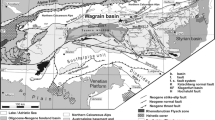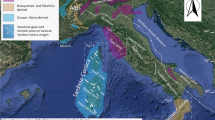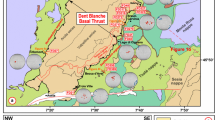Abstract.
The central Menderes Massif (western Turkey) is characterized by an overall dome-shaped Alpine foliation pattern and a N–NNE-trending stretching lineation. A section through the southern flank of the central submassif along the northern margin of Büyük Menderes graben has been studied. There, asymmetric non-coaxial fabrics indicate that the submassif has experienced two distinct phases of Alpine deformation: a top-to-the N–NNE contractional phase and a top-to-the S–SSW extensional event. The former fabrics are coeval with a regional prograde Barrovian-type metamorphism at greenschist to upper-amphibolite facies conditions. This event, known as the main Menderes metamorphism, is thought to be the result of internal imbrication of the Menderes Massif rocks along south-verging thrust sheets during the collision of the Sakarya continent in the north and the Anatolide–Tauride platform in the south across the İzmir–Ankara suture during the (?)Palaeocene–Eocene. Top-to-the S–SSW fabrics, represented by a well-developed ductile shear band foliation associated with inclined and/or curved foliation, asymmetric boudins, and cataclasites, were clearly superimposed on earlier contractional fabrics. These fabrics are interpreted to be related to a low-grade (greenschist?) retrogressive metamorphism and a continuum of deformation from ductile to brittle in the footwall rocks of a south-dipping, presently low-angle normal fault that accompanied Early Miocene orogenic collapse and continental extension in western Turkey. A similar tectono-metamorphic history has been documented for the northern flank of the dome along the southern margin of the Gediz graben with top-to-the N–NNE extensional fabrics. The exhumation of the central Menderes Massif can therefore be attributed to a model of symmetric gravity collapse of the previously thickened crust in the submassif area. The central submassif is thus interpreted as a piece of ductile lower-middle crust that was exhumed along two normal-sense shear zones with opposing vergence and may be regarded as a typical symmetrical metamorphic core complex. These relationships are consistent with previous models that the Miocene exhumation of the Menderes Massif and Cycladic Massif in the Aegean Sea was a result of bivergent extension.
Similar content being viewed by others
Author information
Authors and Affiliations
Additional information
Electronic Publication
Rights and permissions
About this article
Cite this article
Bozkurt, E. Late Alpine evolution of the central Menderes Massif, western Turkey. Int J Earth Sci 89, 728–744 (2001). https://doi.org/10.1007/s005310000141
Received:
Accepted:
Issue Date:
DOI: https://doi.org/10.1007/s005310000141




